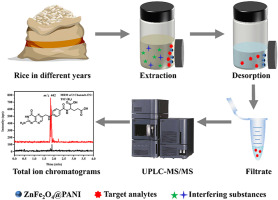Abstract
Rice is an important crop that provides energy and nutrients to humans, which undergoes the aging process, the quality decline is related to the exogenous storage conditions and the change of own enzyme activity. However, due to the complex composition of rice and serious matrix interference, the ageing identification of rice is still challenging. Hence, a novel spinel particles ZnFe2O4@PANI was designed and synthesized for adsorption and determination of vitamin B9, which can be used to distinguish rice in different years and analyze the degree of aging. The ZnFe2O4@PANI showed large specific surface area and fast mass transfer rate with good linear correlation coefficient (R2 = 0.9965), satisfactory recoveries (85.1%-99.9%) and relative standard deviations (RSD, 9.3%). Moreover, the 7C-7C electron-donor-acceptor (EDA) and intermolecular hydrogen-bonding interactions of polyaniline coating provided selective adsorption on vitamin B9. Adsorption thermodynamics study suggested that the adsorption reactions were spontaneous, endothermic and thermodynamically favorable. Finally, ZnFe2O4@PANI was used to evaluate vitamin B9 in rice from different years, which laid a theoretical foundation for exploring the relationship between vitamin changes and the aging degree of the rice.

Keywords Plus:SOLID-PHASE EXTRACTIONFOLIC-ACIDSELECTIVE DETERMINATIONSTORED RICECARBONTHERMODYNAMICSQUANTIFICATIONNANOCOMPOSITESFE3O4-AT-PANIFABRICATION
Published in TALANTA,Volume241;10.1016/j.talanta.2022.123278,MAY 1 2022


